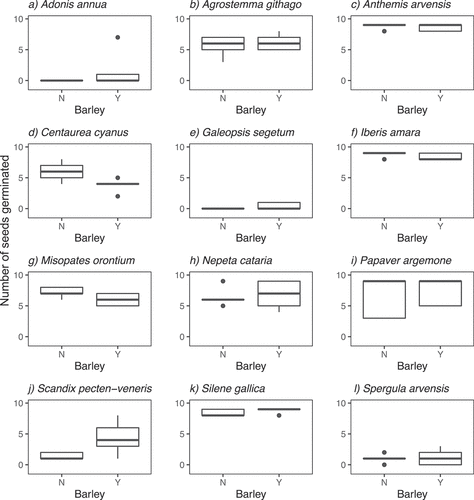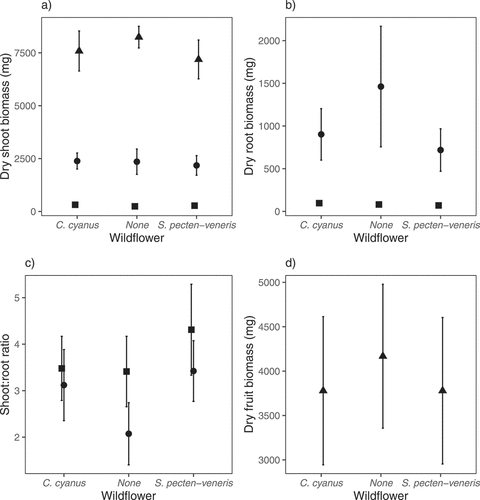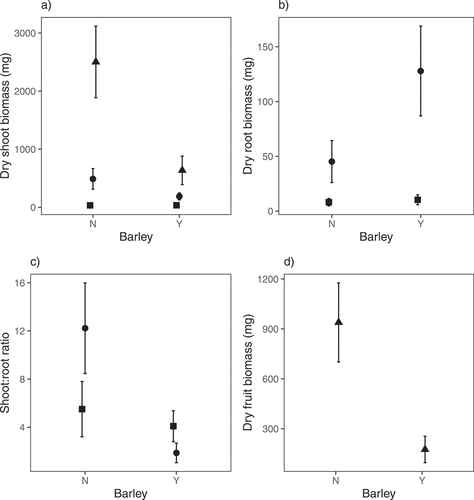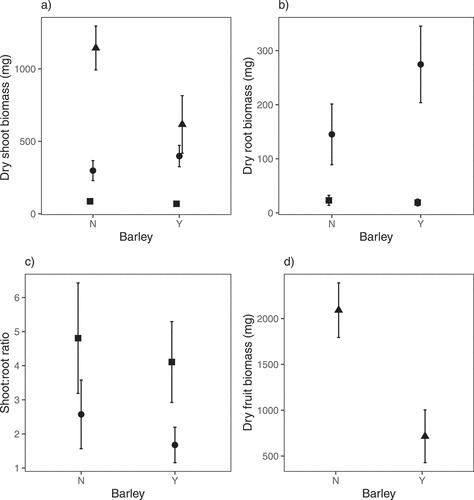Figures & data
Table 1. Full list of rare arable species and supplier information used in Experiments 1 and 2
Table 2. Significance values comparing germination rates of the arable wildflowers grown with and without barley in a glasshouse experiment. Values were generated from randomisation tests with 5000 re-samplings. NA denotes species where either no seeds germinated† or all seeds planted germinated‡
Figure 1. Box and whisker plots of the number of seeds (out of nine) which germinated for 12 arable wildflower species grown in the presence or absence of barley (Hordeum vulgare, cultivar Odyssey) in a glasshouse experiment

Figure 2. Shoot biomass (a), root biomass (b), shoot:root ratio (c) and fruit (inflorescence) biomass (d) of barley at harvest 1 (42 days after sowing – square), harvest 2 (92 days after sowing – circle) and harvest 3 (162 days after sowing – triangle) when grown in the presence of either Centaurea cyanus or Scandix pecten-veneris or without any other plants in a glasshouse experiment. There were no significant negative effects of the arable wildflowers on the barley, but a significant increase in barley shoot:root ratio (relative shoot investment) when arable wildflowers were present (P = 0.005) at harvest two. Means of untransformed data (n = 11*) are presented and error bars are 95% confidence intervals. *n = 10 for barley grown alone at harvest 2

Figure 3. Shoot biomass (a), root biomass (b), shoot:root ratio (c) and fruit (inflorescence) biomass (d) of Centaurea cyanus at harvest 1 (42 days after sowing – square), harvest 2 (92 days after sowing – circle) and harvest 3 (162 days after sowing – triangle) when grown in the presence or absence of barley (cultivar Odyssey) in a glasshouse experiment. Barley had a significant negative effect on shoot biomass, fruit (inflorescence) biomass and shoot:root ratio as the growing season progressed and a significant positive effect on root biomass. Means of untransformed data (n = 11) are presented and error bars are 95% confidence intervals

Figure 4. Shoot biomass (a), root biomass (b), shoot:root ratio (c) and fruit (inflorescence) biomass (d) of Scandix pecten-veneris at harvest 1 (42 days after sowing – square), harvest 2 (92 days after sowing – circle) and harvest 3 (162 days after sowing – triangle) when grown in the presence or absence of barley (cultivar Odyssey) in a glasshouse experiment. Barley had a significant negative effect on shoot biomass and fruit (inflorescence) biomass as the growing season progressed and a significant positive effect on root biomass. Means of untransformed data (n = 11) are presented and error bars are 95% confidence intervals

Boughton_Kettering_Loam.pdf
Download PDF (25.4 KB)Data availability statement
Data and scripts for analysis are available through Dryad digital repository DOI https://doi.org/10.5061/dryad.6t1g1jwvk
